Kenneth L. Gentry Jr.'s Blog, page 15
May 28, 2024
PRETERIST IMPULSES
 PMW 2024-041 by Kenneth L. Gentry, Jr.
PMW 2024-041 by Kenneth L. Gentry, Jr.
The interpretation of the Olivet Discourse that applies its opening portion to first-century Israel is called “preterism.” [1] This theological term derives from the Latin preteritus, which means “gone by, past.” [2] The evangelical, orthodox preterist sees many (not all! [3]) important New Testament prophetic passages as being fulfilled in the first century, thus in our distant past. These prophetic events transpired in the era surrounding the AD 70 destruction of the Jewish temple. These events powerfully, publicly, and permanently close the old covenant, typological era (Heb. 8:13; cp. Matt. 21:33–43; John 4:21–23).
The preterist perspective is initially prompted by two powerful impulses. The first involves the New Testament’s textual notices. These involve various words and phrases that declare near-term expectations. Among these temporal indicators are such words or phrases as: “near” (Matt. 24:33; Rev. 1:3), “quickly” (Luke 18:8; Rev. 22:20), “soon” (Rom. 16:20; Rev. 1:1), “this generation” (Matt. 23:36; 24:34), “some of those who are standing here who will not taste of death until” (Mark 9:1), “you will not finish going through the cities of Israel until” (Matt. 10:23), and so forth.

Perspectives on Pentecost (Richard Gaffin)
A careful examination of the New Testament teaching on the gifts of the Spirit. Makes a case for the cessation of tongues at the close of the apostolic era. Gaffin is professor emeritus of biblical and systematic theology at Westminster Theological Seminary, Philadelphia.
See more study materials at: www.KennethGentry.com
Second, having discovered such textual notices, the perceptive reader is alerted to another indicator: narrative function. Though more subtle, this also suggests an imminent expectation for the events in view. The narrative function involves the unfolding storyline in Matthew’s Gospel, for instance, noting that it anticipates AD 70 destruction of the temple.
As the major biblical statement regarding Israel’s approaching judgment, the Olivet Discourse does not appear in Christ’s teaching as a sudden, disconnected literary aside or random intrusion. In fact, it is not only subtly anticipated throughout Matthew’s whole record, but is certainly expected. It appears as a major discourse well-placed toward the end of the Lord’s ministry as a dramatic climax to his conflict with Israel (Matt. 10:5; 15:24; cp. Matt. 10:15; 11:21–24; 15:24; 23:37; John 1:11) as he begins turning to the Gentiles (Matt. 21:43; 28:20). This is not to say that Matthew stylistically arranges his Gospel so that the Olivet Discourse appears at the end of Jesus’ ministry for narrative effect even though Jesus actually presented it earlier. Jesus himself gave the Discourse toward the end of his ministry. Thus, narrative and history concur.
I am focusing on Matthew’s version of the Olivet Discourse as the longest, most detailed, most distinctive, most highly structured, and best-known account. Now I will show how the apostle carefully and dramatically fits it into his overall narrative flow as he traces out Christ’s ministry and message.
I will deal with this narrative preparation for Olivet in my next posting.
Notes
1. In today’s confused theological environment we must explain that orthodox theology involves “partial preterism”; it is not a one-size fits all construct. See previous PostmillennialWorldview posting.
2. Compact Edition of the English Oxford Dictionary, 2:1330.
3. Some Christians have fallen into hyper-preterism, the view that all key prophecies of Scripture were fulfilled in AD 70, including the second coming of Christ and the resurrection of the dead. For rebuttals against this unorthodox error, see my book Have We Missed the Second Coming? A Critique of the Hyper-Preterist Error (Chesnee, S.C.: Victorious Hope, 2016). See also: Keith A. Mathison, When Shall These Things Be?: Reformed Response to Hyper-Preterism (Phillipsburg, N.J.: P&R, 2004). Samuel M. Frost, Why I Left Full Preterism (Chesnee, S.C.: Victorious Hope, rep. 2019). Jay E. Adams, Preterism: Orthodox or Unorthodox? Stanley, N.C.: Timeless Texts, 2003. Steve Gregg, Why Not Full Preterism?: A Partial-Preterist Response to a Novel Theological Innovation (Maitland, Fla.: Xulon, 2022). C. Jonathin Seraiah, The End of All Things: A Defense of the Future (Moscow, Ida.: Canon, 1999). Peter Holaas, Blessed Hopelessness: Preterist Denial of Biblical and Historic Futurism Examined (Blaine, Wash.: Grace Ministries, 2017).
May 24, 2024
ON MISSING JESUS’ POINT
 PMW 2024-040 by Kenneth L. Gentry, Jr.
PMW 2024-040 by Kenneth L. Gentry, Jr.
The Olivet Discourse has a large presence in the Gospel record (two whole chapters of ninety-seven verses in Matthew, as well as being preserved in Mark 13 and Luke 21). But since so many evangelical Christians are hypnotized by its prophecies of woe (generating multi-million-selling books), and since, as we will see, it is a valuable tool for apologetics in confirming the integrity of biblical prophecy (showing Christ’s ability to prophesy future events), it well deserves our careful consideration in the contemporary eschatological debate.
Unfortunately, Christ’s woe-filled teaching found pointedly here is woefully misunderstood practically everywhere. This is as true among biblical scholars as it is among evangelical students. And it is especially true among self-appointed, back-slapping “prophecy experts” (also known as “televangelists”). Therefore, as Michael Theophilos notes: “It is no understatement to suggest that more ink has been spilt on this chapter, with its synoptic parallels, than on any other in the Gospel narratives.” [1]
Of course, my reader knows that I am an orthodox preterist who sees much of Olivet as referring to the destruction of the Jewish temple in AD 70. But I am an orthodox preterist who theologically remains within the historic Christianity regarding the fundamentals of the faith once for all delivered to the saings. Thus, I am simultaneously affirming that I am a “partial preterist.” By this I mean that preterism is not my theology controlling all aspects of New Testament interpretation. Rather it is my hermeneutic which prevails when required by the biblical context. In this respect, then, I am a preterist-futurist. Let me explain.
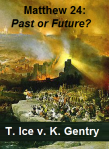 Great Tribulation: Past or Future?
Great Tribulation: Past or Future?
(Thomas Ice v. Ken Gentry)
Debate book on the nature and timing of the great tribulation. Both sides thoroughly cover the evidence they deem necessary, then interact with each other.
See more study materials at: www.KennethGentry.com
As David Turner has noted: “A preterist-futurist view understands the discourse as addressing both the historical destruction of Jerusalem and the yet-future coming of Jesus.” And in arguing this, he points out that “the preterist and futurist views are both reductionistic and cannot handle the complexities of the passage that stem from the disciples’ dual question about the destruction of Jerusalem and the end of the world. A valid approach to the passage must handle both of these matters. [Thus] the preterist-futurist view understands the discourse as addressing both the historical destruction of Jerusalem and the yet-future coming of Jesus.” [2]
Consequently, preterism cannot explain all New Testament prophecies, nor can futurism. They have their own realms of reasonable expectation. We should not be reductionistic by adopting one approach in every instance while discounting the other approach in any instance. Such reductionist thinking does not allow Scripture to speak for itself.
The average evangelical approach to the great tribulation is dominated by a pre-supposed full-scale futurism that overrides contextual indicators in the Olivet Discourse. This is so seriously disorienting that it places the opening section of Olivet (the preterist section, Matt. 24:4–34) at the wrong end of history, applies its judgments to the wrong community, and misplaces its focus geographically, thereby missing Christ’s whole point entirely. Thus, the popular conception has the wrong time, objects, place, and purpose for its judgments. You could not miss the meaning of a prophecy more seriously than through this four-fold failure.

Blessed Is He Who Reads: A Primer on the Book of Revelation
By Larry E. Ball
A basic survey of Revelation from an orthodox, evangelical, and Reformed preterist perspective. Ball understands John to be focusing on the destruction of Jerusalem and the temple in AD 70. Insightful. Easy to read.
For more Christian studies see: www.KennethGentry.com
The dominant, popular (futurist) understanding regarding the great tribulation holds the following:
• Jesus is referring to events in the distant future which are to occur at the very end of the Church age (whereas he is actually speaking of events in the lifetime of his original audience at the end of the old covenant age).
• Jesus is prophesying events regarding a distantly future rebuilt temple ( whereas he is actually prophesying the destruction of the first-century temple).
• Jesus is speaking of catastrophes befalling Gentile unbelievers who persecute the Jews (whereas he is actually focusing on judgments overwhelming the Jews for persecuting Christ and Christians).
• Jesus is declaring judgments engulfing the entire world (whereas he is actually focusing on judgments in Israel).
The two interpretations could hardly be farther apart. These two approaches are known as the futurist view, which teaches that the prophecies of the great tribulation still lie in our future even today, and the partial-preterist view, which teaches that the these prophecies have already occurred in the first century.
Notes
1. Michael P. Theophilos, The Abomination of Desolation in Matthew 24.15 (New York: Bloomsbury, 2012), 81.
2. David L. Turner, Matthew (Baker Exegetical Commentary on the New Testament) (Grand Rapids, Mich.: Baker Academic, 2008), 566.
May 21, 2024
EARLY DATE DIFFICULTIES (3)
 PMW 2024-039 by Kenneth L. Gentry, Jr.
PMW 2024-039 by Kenneth L. Gentry, Jr.
I am continuing a brief series on problems scholars have with the early (pre-AD 70) date of Revelation. I am using his Leon Morris’ book: The Revelation of St. John (2d. ed.: Grand Rapids: Eerdmans, 1987) as my main source. Let’s get to work!
A most unusual phenomenon seems to appear in Revelation, according to Morris. His third argument is very popular among late-date theorists. This evidence regards the very unusual and ancient legend known as the Nero Redivivus myth. Morris briefly explains the myth and confidently employs it: “Again, it is urged that the book shows evidence of knowledge of the Nero redivivus myth (e.g. xvii. 8, 11). After Nero’s death it was thought in some circles that he would return. At first this appears to have been a refusal to believe that he was actually dead. Later it took the form of a belief that he would come to life again. This took time to develop and Domitian’s reign is about as early as we can expect it” (Morris 37).
In providing the myth as late-date evidence David Aune boldly claims that “it is not likely that the Nero redivivus or Nero redux myth was widely circulated until the end of the first century A.D.”[1] In Moffatt’s commentary on Revelation 17 he speaks strongly of the myth’s role in interpreting the passage, when he noted that “the latter trait is unmistakably due to the legend of Nero redivivus, apart from which the oracle is unintelligible.” [2]
Nero so fearfully impressed the world in his era that pagan, Jewish, and Christian legends quickly sprang up around his death. These legends asserted themselves among the general populace throughout the far-flung reaches of the empire. In the pagan literature references to the expectation of Nero’s return after his fall from power may be found in the writings of Tacitus, Suetonius, Dio Cassius, Xiphilinus, Zonaras, and Dion Chrysostom. [3] Among the Jews the myth surfaces in the Talmud. In Christian circles :Lt is mentioned in books by Lactantius, Sulpicius Severus, Jerome, and Augustine. [4] Several Sibylline Oracles of various origins — Christian, Jewish, and pagan — use the myth as well. [5]
Greatness of the Great Commission (by Ken Gentry)
An insightful analysis of the full implications of the great commission. Impacts postmillennialism as well as the whole Christian worldview.
See more study materials at: www.KennethGentry.com
Interestingly, the myth was not simply a “wives’ tale” of little significance. It had a measurable impact even on political affairs. Pretenders to the imperial throne, claiming to be Nero used the myth in quests for power. [6].
Clearly the existence, spread, and influence of the Nero Redivivus myth cannot be disputed. It is one of the most fascinating and best-known legends in all of political history. But the questions with which we must deal are: Does the myth appear in Revelation? And if so, does this necessitate a late date for the composition of Revelation?
Despite the confidence with which some late-date advocates employ the Nero Redivivus myth, two intriguing facts arise in regard to its use by Biblical scholars.
First, not all late-date proponents allow the argument as helpful to the question of the dating of Revelation. Donald B. Guthrie, a most able late-date adherent, carefully considers the merits of the Nero Redivivus argument, but discourages its endorsement in the debate: “If then an allusion to the Nero myth is still maintained as underlying the language of Revelation xiii and xvii, it must be regarded as extremely inconclusive for a Domitianic date. The most that can be said is that it may possibly point to this.” [7] In fact, some admit it could arise soon after Nero’s death: “Given the presence of this legend, the Book of Revelation cold not have been written in its present form before 68 CE when Nero died, but the legend could have spread quickly after Nero’s death.” [8]
Second, a number of early date advocates believe the myth appears in Revelation, but still maintain the Neronic dating position. John A. T. Robinson is a case in point: “As virtually all agree, there must be a reference to Nero redivivus in the beast that ‘once was alive and is alive no longer but has yet to ascend out of the abyss before going to perdition.” [9]
It is most interesting to find proponents of both dating positions able to admit the presence of an element which the late-date school proffers as a leading proof for its position! Beyond these two initial problems, however; significant and reasonable possibilities available to hand wholly undermine the Nero Redivivus argument for a late date.
Despite the intriguing correspondences between the Nero Redivivus myth and some of Revelation prophecies, the two are not related. We may easily interpret the relevant passages in a way that has nothing whatsoever to do with the Nero Redivivus myth. In addition, this interpretation is more appropriate, not only in regard to one of the major events of the first century, but also to the theme of Revelation. What John is speaking about is not a myth, but the historical phenomena associated with the death of Nero, the near demise of Rome, and its reestablishment under Vespasian.
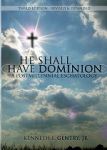
He Shall Have Dominion (Kindle version) by Kenneth Gentry
A classic, thorough explanation and defense of postmillennialism (600+ pages). Complete with several chapters answering specific objections.
See more study materials at: www.KennethGentry.com
Late-date proponent James Moffatt is particularly interesting at this point. He attempts to hold to the best of both worlds: (1) He vigorously attests that the Nero Redivivus myth appears in Revelation 13 and 17. He urges that its appearance helps establish the late date for Revelation, in that its highly developed form is not possible until Domitian’s reign (A.D. 81-96). [10] (2) But then he also adopts the interpretation of Revelation 13 and 17 like I suggest: That the death wound and revival of the beast refer to the Roman Civil Wars of A.D. 68-69. Notice his comments on Revelation 13:3:
The allusion is . . . to the terrible convulsions which in 69 A.D. shook the empire to its foundations (Tac Hist. i. 11). Nero’s death with the bloody interregnum after it, was a wound to the State, from which it only recovered under Vespasian. It fulfilled the tradition of the wounded head. . . . The vitality of the pagan empire, shown in this power of righting itself after the revolution, only added to its prestige. [11].
Thus, a vigorous late-date advocate and Nero Redivivus enthusiast admits that the references allude to the Roman Civil Wars and Rome’s revival under Vespasian. This is a telling admission. If the references in question can be applied to the Roman Civil Wars of A.D. 68-69, how can these same references point to Nero Redivivus and demand an A.D. 96 date for the book?
If the verses in Revelation can properly be understood as making reference to the earth-shaking historical events of the era, why would any commentator be driven to employ a myth to make sense of the passages? And this being the case, how can the myth be used as a major chronology datum from the internal evidence?
From our observations, it is obvious that the Nero Redivivus myth cannot be used with any degree of success to establish a late date for Revelation. There is good reason to doubt that it even appears in Revelation. The presumed evidence based on this myth cannot undermine the facts derived from the documented historical matters by which we may establish its early date.
Notes
David E. Aune, Revelation 1-5, lxi. See also: James Moffatt, Revelation, 317.James Moffatt, Revelation, 450.Tacitus, Historic 1:2; 2:8, 9; Suetonius, Nero 40, 57, Domitian 6; Dio Cassius, Roman History 63:9:3; 66:19:3; Xiphilinus 64:9; Zonaras, Annals 11:151-8; and Dion Chrysostom, Orations l.Lactantius, On The Death of the Persecutors 2; Sulpicius Severus, Sacred History 2:28; Jerome, Daniel 11:28; and Augustine, The City of God 20:19:3.Sibylline Oracles 3:63ff.; 4:1 15ff.; 5:33ff.; 8:68ff.; 12:78; 13:89ff.Tacitus, Histories 1:78; 2:8; Suetonius, Nero 57.Donald B. Guthrie, New Testament Introduction, 4th ed. (Downers Grove, Ill.: Inter-Varsity, 1990), 953.Leonard L. Thompson, The Book of Revelation: Apocalypse and Empire (New York: Oxford, 1990), 14.John A. T. Robinson, Redating the New Testament (Philadelphia: Westminster, 1976), 245. Moses Stuart and E. Earle Ellis are orthodox orthodox early-date scholars who allow that the myth appears in Revelation. Moses Stuart, Commentary on the Apocalypse (Andover: Allen, Morrill, Wardwell, 1845). E. Earle Ellis, The Making of the New Testament Documents (Boston: Brill, 1999), 212.Moffatt, Revelation, 317.Moffatt, Revelation, 430.Interestingly, Mounce does the same thing: On page 19 of his work, he employs the myth to demonstrate a late date for Revelation, but in his commentary at Revelation 13 and 17 he opts for the revival-of-the-Empire interpretation (Revelation, 248, 318).May 17, 2024
EARLY DATE DIFFICULTIES (2)
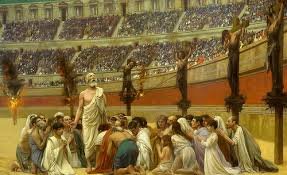 PMW 2024-038 by Kenneth L. Gentry, Jr.
PMW 2024-038 by Kenneth L. Gentry, Jr.
Revelation’s early date is generally held by modern postmillennialists of the preterist variety. I have argued elsewhere positively for the early date. So here I am offering a short series that briefly responds to late-date evidences. I am focusing on Leon Morris’ arguments, due to their cogency, succinctness, and his stature as a Revelation commentator.
Morris discovers “indications that Revelation was written in a time of persecution.” This evidence is felt to accord “much better with Domitian.” [1] W. G. Kümmel is quite confident that “the picture of the time which the Apocalypse sketches coincides with no epoch of the primitive history so well as with the period of Domitian’s persecution.” [2] Morris, Kümmel, and a number of other scholars list this as among their leading arguments for the A.D. 95-96 date.
I agree that it seems clear enough that in Revelation imperial persecution against the faith has begun. But the evidence heavily favors a Neronic (A.D. 64-68) persecution rather than a Domitianic (A.D. 95-96) one. In fact, it is extremely difficult to even prove a Domitianic persecution — secular history is totally silent on the possibility.
Surprisingly, when we turn to Morris’s own presentation, we are frustrated as we seek sure conviction: “While later Christians sometimes speak of a persecution under Domitian the evidence is not easy to find.” [3] Many scholars understand Domitian’s violent conduct in A.D. 95 as a paranoid outburst. [4] It seemed to concentrate on “selected individuals whom he suspected of undermining his authority.” [5] The problem with the evidence for this “persecution” is that it proceeds solely from Christian sources — sources somewhat later than the events. A Domitianic persecution is not mentioned by any secular historian of the era.
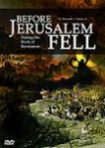
Before Jerusalem Fell Lecture (DVD)
DVD by Ken Gentry
A summary of the evidence for Revelation’s early date. Helpful, succinct introduction to Revelation’s pre-AD 70 composition.
See more study materials at: www.KennethGentry.com
Though the historicity of a Domitianic persecution of Christianity is questioned, such cannot be the case with the persecution under Nero. Although many scholars argue that the Neronic persecution was confined to Rome and its environs, the indisputable fact remains: Nero cruelly persecuted Christianity, taking even the lives of its foremost leaders, Peter and Paul. The evidence for the Neronic persecution is overwhelming and is documentable from heathen, as well as Christian, sources.
In Before Jerusalem Fell I showed clear evidence of a Neronic persecution from the writings of several pagan and Christian writers of the era. To that list let me now add Tertullian (A.D. 150-220), who was a lawyer who wrote in Latin, the legal language of the Roman Empire. In defending Christianity, he challenged men to search the archives of Rome for the proof that Nero persecuted the Church: “Arid if a heretic wishes his confidence to rest upon a public record, the archives of the empire will speak, as would the stones of Jerusalem. We read the lives of the Caesars: “At Rome Nero was the first who stained with blood the rising faith.” [6] Surely he would not issue a challenge to search the archives of Rome, which could easily be taken and just as easily refuted, were his statement untrue.
 Keys to the Book of Revelation
Keys to the Book of Revelation
(DVDs by Ken Gentry)
Provides the necessary keys for opening Revelation to a deeper and clearer understanding.
See more study materials at: www.KennethGentry.com
Indisputably, the sheer magnitude, extreme cruelty, and paradigmatic role of Nero’s persecution of Christianity fit well the role required in Revelation. Thus, we are led again to repeat: The Domitianic evidence is doubtful and, if accepted at all, pales in comparison to Nero’s. Interestingly, late-date advocate Robert Mounce, like so many others, admits that “the evidence for widespread persecution under Domitian is not especially strong.” Yet, he goes on rather boldly to add that “there is no other period in the first century in which it would be more likely”! [7] No other period?
The late-date use of the persecution theme in Revelation can neither establish the late date for Revelation, nor compete with the early date evidences.
Notes
Morris, Revelation, 37.W. G. Kümmel, Introduction to the New Testament, trans. Howard Clark Kee, 17th ed. (Nashville: Abingdon, 1973), 328.Morris, Revelation, 36For example, J. Ramsey Michaels, Revelation (IVPNTC) (Downers Grove, Ill.: InterVarsity Press, 1997), 19. M. Eugene Boring, Revelation: Interpretation: A Bible Commentary for Teaching and Preaching (Louisville: John Knox, 1989), 17.Glenn W. Barker, William L. Lane, and J. Ramsey Michaels, The New Testament Speaks (New York: Harper and Row, 1969), 368.Tertullian, Scorpion’s Sting 15.Robert Mounce, The Book of Revelation (2d. ed.: Grand Rapids: Eerdmans, 1998), 34.May 14, 2024
EARLY DATE DIFFICULTIES (1)
Objections, Preterism, Revelation

PMW 2024-037 by Kenneth L. Gentry, Jr.
Preteristic postmillennialists hold that Revelation was written prior to the destruction of Jerusalem and the temple in AD 70. We argue this on historical and exegetical grounds. We do not argue for an early date for Revelation on purely theological grounds in order to defend our long-range hope against John’s enormous judgment scenes.. I have argued the case of the early date of Revelation in several places, most especially in my doctoral dissertation published as Before Jerusalem Fell. In this brief series of articles I will respond to four leading arguments against the early date.
The modern case for the late date of Revelation concentrates upon four basic arguments. These have been ably and succinctly summarized by noted evangelical scholar and late-date advocate Leon Morris in his commentary, The Revelation of St. John (2d. ed.: Grand Rapids: Eerdmans, 1987). I choose to investigate Morris’s approach for three basic reasons.
(1) He has rightfully earned an international reputation among both evangelical and liberal scholars. (2) He has a demonstrated competence in the field of New Testament studies, having even produced an excellent commentary on Revelation itself. (3) His presentation is succinct and focused, which lends itself to blog analysis. The order of my listing of these evidences will follow Morris’s, which is based on his scholarly estimation of their priority.
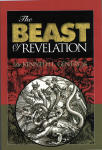
The Beast of Revelation
by Ken Gentry
A popularly written antidote to dispensational sensationalism and newspaper exegesis. Convincing biblical and historical evidence showing that the Beast was the Roman Emperor Nero Caesar, the first civil persecutor of the Church. The second half of the book shows Revelation’s date of writing, proving its composition as prior to the Fall of Jerusalem in A.D. 70. A thought-provoking treatment of a fascinating and confusing topic.
For more study materials, go to: KennethGentry.com
Morris begins with what he calls “the principal reason for dating the book during” Domitian’s reign, which is: Revelation “contains a number of indications that emperor-worship was practised, and this is thought to have become widespread in Domitian’s day” (p. 35).Earlier than Morris, James Moffatt insisted that the role of emperor worship in Revelation was virtually conclusive: “When the motive of the Apocalypse is thus found in the pressure upon the Christian conscience exerted by Domitian’s emphasis on the imperial cultus, especially as that was felt in Asia Minor, any earlier date for the book becomes almost impossible.” [1]
This argument regarding emperor worship is also held by Robert H. Mounce, R. H. Charles, H. B. Swete, Donald B. Guthrie, W. G. Kümmel, M. Eugene Boring, William Barclay, and many others. References in Revelation which seem to reflect emperor worship are found in scattered places. See especially Revelation 13:4, 8, 12, 15; 14:9, 11; 16:2; 19:20; 20:4. The most noteworthy statements re found in Revelation 13, where worship of the “beast” is compelled.
Unfortunately, for this view emperor worship dates back to Julius Caesar in the last century before Christ. And it is endorsed by Nero, the emperor who commissions Vespasian to put down the Jewish rebellion (which results in the destruction of the temple). The emperor cult had a prominent role in the political and social life of the Roman empire well before Domitian, and even before Nero.
Although it is true that historical development continued to introduce new features and requirements into the practice, nevertheless after 30 B.C. “we can observe a swift spread of the emperor cult throughout the Roman Near East.” [2] As even late-date advocate James Moffatt wrote: “The blasphemous title of dims, assumed by the emperors since Octavian (Augustus = sebastos) as a semi-sacred title, implied superhuman claims which shocked the pious feelings of Jews and Christians alike. So did theos [god] and theou huios [son of god] which, as the inscriptions prove, were freely applied to the emperors, from Augustus onwards.” [3]

Before Jerusalem Fell Lecture (DVD)
DVD by Ken Gentry
A summary of the evidence for Revelation’s early date. Helpful, succinct introduction to Revelation’s pre-AD 70 composition.
See more study materials at: www.KennethGentry.com
The appearance of emperor worship in Revelation is held by many late-date theorists as the strongest evidence for a date during the last year of the reign of Domitian (A.D. 81-96). It is true that Domitian required people to address him as “Lord and God.” Certainly the emperor cult was prominent in his reign. Yet when we scrutinize the relevant historical evidence we discover abundant testimony to emperor worship at various stages of development well before both Domitian and Nero. Indeed, such clear statements exist of so many aspects of the emperor cult, it is surprising that this argument is used at all against the early date. One wonders why it is deemed “the principal reason” (Morris) that makes it “almost impossible” (Moffatt) for the early date view to stand is wholly incredible.
Notes
James Moffatt, The Revelation of St. John the Divine, vol. 5 in W. Robertson Nicoll, ed., The Expositor’s Greek Testament (Grand Rapids: Eerdmans, rep. 1980), 317.Doron Mendels, The Rise and Fall of Jewish Nationalism: Jewish and Christian Ethnicity in Ancient Palestine (Grand Rapids: Eerdmans, 1992), 278.Moffatt, Revelation, 429. See also: Aune, Revelation 1-5, lxviii; Leonard L. Thompson, The Book of Revelation: Apocalypse and Empire (New York: Oxford, 1990), 104-190.May 10, 2024
THE END-TIME RESURRECTION (3)
 PMW 2024-036 by Kenneth L. Gentry, Jr.
PMW 2024-036 by Kenneth L. Gentry, Jr.
In this article I am concluding a three-part series on our resurrection as taught by Paul in 1 Cor 15. This continues the previous presentation outlining Paul’s second argument in his great resurrection chapter. The other two articles need to be consulted before jumping into this one. Unless you are good at back masking, and you can hum well..
(3) Paul’s parallels and contrasts show his concern is not physical v. immaterial, but perishable v. imperishable (v. 42), dishonor v. honor (v. 43a), and weakness v. power (v. 43b). Our resurrected condition is so governed by the Holy Spirit that the weaknesses of our present condition will be totally overcome by the transformational power of the Spirit. Indeed, he emphasizes the difference of glory as the key (vv. 40-41).
(4) According to scholars such as A. T. Robertson, generally adjectives ending in –inos denote compositional material, whereas those ending with –ikos signify characteristics. This fits the flow of Paul’s argument regarding the “natural”(psuchikos) and the “spiritual” (pneumatikos) body as I have presented it — and it supports the historic faith of the Church regarding the resurrection.
KEYS TO THE BOOK OF REVELATION (DVD lectures)
By Ken Gentry
These four lectures provide the necessary keys for opening Revelation to a deeper and clearer understanding. Excellent for individual or group studies.
See more study materials at: www.KennethGentry.com
(5) Once again Paul brings in the parallel between Adam and Christ as illustrating the differing circumstances of our estates (vv. 45-48). In verse 45 he applies Genesis 2:7 in light of his resurrection argument, contrasting the Adamic condition (the first Adam) with the resurrected Christ (the second Adam). (He cites the LXX: “the man became a living [psuchen] soul.”) Adam’s body was a psuchen body subject to animal weaknesses (hunger, death, and so forth, Gen. 1:29; 2:17). Once again we have the distinction between the psuche (soul) and pneuma (spirit): But we know that Adam was not immaterial, nor was Christ in his resurrection. The idea here is that just as Adam is the source of our perishable bodies as the “first Adam,” so Christ is the source of our Spirit-powered bodies as the “last Adam” (the man of the last estate or condition of the redeemed). Thus, Paul is drawing the parallel between the two material bodies and their consequent conditions (cp. v. 22), then noting the superiority of the consummate state represented in Christ’s resurrection condition.
(6) In verse 47 (“the first man is from the earth, earthy; the second man is from heaven”) Paul is not speaking of the origin of Adam and of Christ, but the quality of their conditions (focusing on the resurrected Christ). He is reiterating the difference between their weakness/power, inglorious/glorious conditions. Resurrected believers share the heavenly life of Christ but are not from heaven themselves. Paul contrasts the resurrection body with the Genesis 2:7 Adam (vv. 45-46). Thus, “just as we have borne the image of the earthy, we shall also bear the image of the heavenly” (v. 49). We shall wear the image of the heavenly Second Adam, whatever his resurrection was like.
(7) In verse 50 he contrasts man’s fallen condition with his eternal condition in Christ: “Now I say this, brethren, that flesh and blood cannot inherit the kingdom of God; nor does the perishable inherit the imperishable.” The phrase “flesh and blood” shows the need for transformation. It highlights the weakened, sinful estate, not the material condition. In the LXX “flesh and blood” stands for human weakness as subject to and indicative of death (cf. Deut. 32:42; Isa. 49:26; Jer. 51:35; Eze. 39:17-18; Zeph. 1:17). Therefore, “flesh and blood” parallels with the decayed realm, for “this perishable must put on the imperishable, and this mortal must put on immortality” (v. 53) Paul uses touto (“this”) four times: twice in 53 and twice in 54. His use of “this” demands continuity of the body (this body) even during transformation to the resurrected estate.
MATTHEW 24 DEBATE: PAST OR FUTURE?
Thomas Ice and Kenneth Gentry
Two hour formal, public debate between Ken Gentry and Thomas Ice on the Olivet Discourse. Pits orthodox preterism against revised dispensationalism.
See more study materials at: www.KennethGentry.com
Conclusion
When all is said and done, the historic position of orthodox Christianity is sustained. Christ was physically resurrected (though with transformed powers) and so shall we be. God created man as distinct from angels. We are designed to be physical creatures for: (1) God sovereignly and purposely created the objective, material world in which we live (Gen 1; Psa 33:6-11). (2) He lovingly and carefully formed our physical bodies for dwelling in this material world (Gen 2:7-24) which he has entrusted to man (Psa 8:1-9; 115:16). (3) He brought his objective, propositional revelation to us through the historical process of inspiration and inscripturation by means of men moved by the Spirit of God (2 Tim 3:16-17; 2 Pet 1:20-21). (4) In the Second Person of the Trinity, God took upon himself a true human body and soul (which he still possesses, Col 2:9) and entered history for the purpose of redeeming men back to a right relationship with him (Rom 1:3; 9:5; Heb 2:14). (5) His elect people will inherit the eternal estate in resurrected, physical bodies (John 5:28-29; 1 Cor 15:20-28) so that we might dwell in a material New Creation order (2 Pet 3:8-13).
May 7, 2024
THE END-TIME RESURRECTION (2)
PMW 2024-035 by Kenneth L. Gentry, Jr.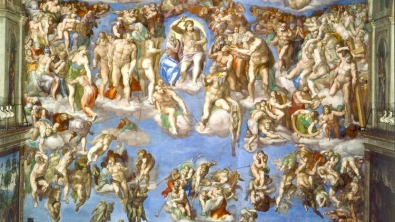
This is the second of three articles on our eschatological resurrection as understood in the postmillennial system. For Paul, Christ’s resurrection was a non-negotiable. And it was also the key to our own future resurrection. As I continue the previous study we come now to:
Paul’s First Argument
After insisting that Christ was resurrected from the dead and that this is the foundation of our redemptive hope (vv. 1-19), Paul then powerfully links our resurrection to Christ’s. In other words, his whole point regarding Christ’s resurrection is to lay a foundation for ours. In verse 20 we read: “But now Christ has been raised from the dead, the first-fruits (Gk., aparche) of those who are asleep.” This first-fruits imagery carries a load of theological implications regarding our physical resurrection.
First, the temporal significance of “first” requires that Christ’s resurrection is peculiarly the first of its kind. No other consummate-order resurrection occurred previously. Second, in that he is the “first-fruit” he represents the rest, just as the Old Testament offering of the first part of the harvest represented the whole harvest (cp. Rom. 11:16). Christ’s resurrection represents our own. Third, the “first-fruit” also promises more to come. Christ’s was unique for the time, but it spoke of others to follow at “the end” (v. 24). Thus, the resurrection of Christ as the first-fruits is: (1) the first of this order to occur, (2) represents his people’s resurrection, and (3) expects more eschatological resurrections to follow at the end.
_______________________________________________________________________________
BEAST OF REVELATION: IDENTIFIED
By Ken Gentry
A popularly compiled presentation that serves as an antidote to dispensational sensationalism and newspaper exegesis. Convincing biblical and historical evidence showing that the Beast was the Roman Emperor Nero Caesar, the first civil persecutor of the Church. The second half of the book shows Revelation’s date of writing, proving its composition as prior to the Fall of Jerusalem in A.D. 70. A thought-provoking treatment of a fascinating and confusing topic.
For more study materials, go to: www.kennethgentry.com
Consequently, the fact of Christ’s resurrection is essential to the believer’s resurrection — and anticipates it. From Adam death arose and all of its processes; so from Christ life arises and its fullest blessings (vv. 21-28). The resurrection of Christ is necessary for the triumph of life over death (vv. 25-26), which will finally and fully be enjoyed only when we ourselves are raised from the dead and the “last enemy” is defeated (v. 26). It is fundamentally important to Paul.
In verses 29-34 Paul presents a relentless and vigorous ad hominem against his Corinthian opponents: He notes he is risking his life for what the Corinthians deny (v. 30-32). He lashes out against their spiritual pride in thinking they have arrived at the fullness of Holy Spirit blessings (v. 33). He warns that their “bad company” on this matter has “corrupted good morals” (v. 33; cp. 1 Cor. 6-7 particularly). They must become “sober” and “stop sinning” in this (v. 34). And all of this in the context of his argument for the resurrection of believers!
Thus, once we determine the nature of Christ’s resurrection, we understand the nature of our own. If Christ was physically raised from the dead, then so shall we, for he is the “first-fruits” of our resurrection. The only way around our physical resurrection is to deny Christ’s physical resurrection.
Paul’s Second Argument
Paul finally arrives at the specific objection toward which he has been driving: “But someone will say, ‘How are the dead raised? And with what kind of body do they come?'” (v. 35). Here he is clearly speaking of a physical resurrection in that: (1) His opening question concerns how the “dead” are “raised,” that is, “with what kind of body“? (2) The verb “raised” is attached to “the dead” in verses 1-34, and to their actual “bodies” in verses 35-58. And since he is dealing with their objection regarding a physical resurrection he now emphasizes the “body” (soma) in this portion of his argument (vv. 35, 37, 38, 40, 42, 44). (3) Christ’s resurrection from “the dead” is the key to the whole passage and argument (vv. 12, 13, 15-16), and his was a physical resurrection. In fact, Christ’s resurrection is mentioned in the context of his being “dead,” “buried,” and “raised.” Christ’s body was buried; so his body is what raised.
Contrary to their quasi-gnostic, hyper-spiritual, eschatologically-conditioned claims, Paul establishes the death of the body as the pre-condition for the fullness of the life they presently claim. He illustrates this by the seed that is sown, which must “die” (vv. 36-37) so that it can be raised to eschatological glory. Despite their pride of “having arrived,” the pneumatic Christians cannot “be there” yet. Their bodies haven’t been “sown.”
In verses 38-41 Paul emphasizes two crucial truths in response to their question (v. 35): (1) “God gives it a body just as he wished” (v. 38a). As with Augustine later, all objectors must recognize: “Is he who was able to make you when you did not exist not able to make over what you once were?” (Sermons on Ascension, 264:6). Any objection regarding the difficulty of resurrecting a dead body is more than accounted for by the fact that it is God who effects it.
(2) God gives bodies appropriate to their environment (v. 38b). He gives fish bodies appropriate to water, birds appropriate to flight, and so on (vv. 39-41). And all bodies have a level of “glory” appropriate to their estate (v. 40-41), whether they be “earthly” or “heavenly” (v. 40). The glorious condition of the resurrected body is adapted for victory over the decay element. Though our pre-eschatological condition suffers dishonor and weakness, our future estate will enjoy glory and power (vv. 43-44; cp. Rom. 8:11; 2 Cor. 4:7-12; Phil. 3:21). In fact, it is “the body” itself that will be transformed from being perishable to imperishable (vv. 42, 52-54).
_________________________________________________________________________________
THE CLIMAX OF THE BOOK OF REVELATION (DVDs)
By Ken Gentry
Six lectures on six DVDs that introduce Revelation as a whole, then focuses on its glorious conclusion. Provides an important, lengthy Introduction to Revelation also.
See more study materials at: www.KennethGentry.com
Paul employs shock therapy against these pneumatics: “It is sown a natural body, it is raised a spiritual body. If there is a natural body, there is also a spiritual body” (1 Cor. 15:44). His point appears to be that not only should they not denigrate the present material order (which they have done, chs. 6-7), but he informs them that they will be resurrected in a “spiritual body” in the eschatological order! And here is where the Hyper-Preterist theological naivete causes them to stumble so badly. Hyper-Preterists believe Paul’s reference to the “spiritual body” speaks of the substance of the body, its compositional makeup. Consequently, they are emboldened to employ this verse for discounting a physical resurrection. Of course, this is as wrong-headed as to say a Coca-Cola bottle is made of Coca-Cola. Note the following evidences supporting the orthodox approach to Paul’s argument (to name but a few):
(1) This “spiritual (pneumatikos) body” is no more immaterial than the “natural (psuchikos) body,” even though both “spirit” (pneuma) and “soul” (psuche) often refer to the immaterial element within the creature. Here Paul uses these (usually spiritual) terms to describe the body, and we know that our present natural (psuchikos) body is material. In 1 Corinthians 2:14 these adjectives distinguish the believer and the unbeliever. Rather than distinguishing their body materials, the terms focus on their driving forces: spiritual (Holy Spirit driven) concerns over against animal appetites
(2) In Paul the semantic domain for pneuma overwhelming means “pertaining to the Holy Spirit” (e.g., 1 Cor. 2:13; 3:1; 12:1; Rom. 1:11; Eph. 1:3; 5:19). That is, governed by the Spirit of God. The adjectives psuchikos and pneumatikos describe, therefore, the essential governing characteristic of each body: the present, unresurrected, fallen body over against the future, resurrected, redeemed body. That is, they speak of the earth-related, animal-appetite-controlled condition of the present order (the totality of man in his earthly estate) over against the eternity-related, Holy Spirit-controlled condition of the resurrected estate (the totality of man in his eternal estate). The glory of the eschatological state entered into by the eschatological resurrection involves the full dominance of the Holy Spirit and all that that entails (including the body’s imperishable condition and its moral control). And contextually, Paul designs his response to confront the prideful Corinthian pneumatics who think they have arrived at full spiritual glory. (Later Paul will note that the natural is first, not the spiritual, showing that the Corinthians must first live out their present lives before attaining the fullness of the Spirit, v. 46).
(To be continued).
May 3, 2024
THE END-TIME RESURRECTION (1)
PMW 2024-034 by Kenneth L. Gentry, Jr.
As Christians we recognize the resurrection of Christ as of enormous significance in the Christian worldview. Paul dogmatically states: “if Christ has not been raised, your faith is worthless; you are still in your sins” (1 Cor 15:17). Clearly for him, Christ’s resurrection is foundational to our hope of salvation.
In this article I will deal with just one of the redemptive-historical effects of Christ’s resurrection: the eschatological resurrection of believers. Christ’s resurrection not only secures our present redemption for glory (Rom. 4:25; 10:9-10) but our future resurrection to glory (Rom.8:23).
Unfortunately, a new gnosticism is infecting the church: Hyper-preterism. One major feature of Hyper-Preterism is its denial of a future physical resurrection of the believer at the end of history. As we shall see, this contradicts a major result of the resurrection of Christ. Before I demonstrate this, I must briefly summarize the argument for Christ’s physical resurrection, which is the effective cause of our own future resurrection.
The Scriptures teach that Christ was resurrected in the same body in which he died: The very body in which he died was raised from the dead, just as he prophesied (John 2:18-19, 21). As such, it miraculously attested to the truth of his divine mission on earth (Matt. 12:39-40). This is why the tomb and his burial clothing were found empty: His physical body had departed from them (Matt. 28:6; John 20:4-11, 15). The gospels present the resurrected Christ in a material body that could be touched and handled (Luke 24:39), which still had the wounds of the cross (John 20:27; cf. Rev. 5:6), which could be clung to (John 20:17; Matt. 28:9), and could eat food (Luke 24:42-43; John 21:11-14). Christianity has always affirmed the corporeal resurrection of Christ as a prominent feature of its high supernaturalism.
__________________________________________________________________________________________
WHEN SHALL THESE THINGS BE?
(ed. by Keith Mathison)
This is a Reformed response to the aberrant HyperPreterist theology. Gentry’s chapter critiques HyperPreterism from an historical and creedal perspective.
See more study materials at: www.KennethGentry.com
But how does that speak to the issue of our resurrection? In that my space is limited I will simply provide an abbreviated commentary on 1 Corinthians 15 which speaks directly to the point and is a favorite passage for Hyper-Preterists. They gleefully point out that Paul speaks of a “spiritual body” (v. 44) and argues that “you do not sow the body which is to be” (v. 37).
The Corinthian Context and Problem
Before surveying this chapter we must be aware of a major underlying problem in this church located in the Greek city of Corinth: A mixture of a quasi-gnostic philosophy (highlighting higher knowledge and denigrating the physical realm) and an exorbitant pride rooted in pneumatic-eschatological claims.
Indeed, Paul opens his letter by referring to their pneumatic gifts (1:7; cp. chs. 12-14) and the matter of a Greek concern for “knowledge” (1:18-25; cp. chs. 2-4, 8-10). These issues almost invariably lie behind the particular problems he addresses. For example, their sexual immorality was rooted in their unconcern with issues of physical morality (1 Cor. 6:13, 15; “the body doesn’t matter! what’s the problem?”) and their denial of legitimate sexual relations in marriage (1 Cor. 7:1-4; ” we are above physical relations”). And their charismatic abuses are quite well-known (1 Cor. 12-14). They even revolted against local social conventions and boundary markers in disregarding public decorum in dress (hair style) by their “eschatological women” (1 Cor. 11; see Gordon Fee’s commentary). These women asserted that since the eschaton has come, then the resurrection is past — consequently, they are like the angels in heaven who have no need of marriage nor differentiation from males (based on Matt. 22:30).
Fortunately, Hyper-Preterists do not promote immorality, yet their doctrinal outlook has remarkable parallels to the Corinthian paradigm. But I must move quickly to the problem at hand, showing that Hyper-Preterism strikes at the vitals of our holy faith through flawed exegesis.
Introducing the Problem and the Solution
In 1 Corinthians 15 Paul focuses on a denial of the resurrection of the body. In the first part of his argument for the resurrection (vv. 1-34) he repeatedly expresses his concern for its necessity: “if the dead are not raised” (15:12, 13, 15, 16, 29, 32). To dispel all doubt about our resurrection he links Christ’s resurrection to ours (as elsewhere: Rom. 8:1; 1 Cor. 6:14; Phil. 3:21). As we will see, this linkage powerfully affirms the physical resurrection.
___________________________________
WHY I LEFT FULL-PRETERISM
by Samuel M. Frost
Former leader in Full Preterist movement, Samuel M. Frost, gives his testimony and theological reasoning as to why he left the heretical movement. Good warning to others tempted to leave orthodox Christianity.
See more study materials at: www.KennethGentry.com
___________________________________
In the second part of his response (vv. 35-57) Paul adapts his argument for the resurrection to the pneumatic-eschatological theology of his audience. He rebuts them by responding to their spiritual pride regarding “knowledge” and “gifts.” He argues that they themselves have not yet received the full spiritual blessings of redemption (and neither will they in a few weeks, as per the ludicrous Hyper-Preterist A.D. 70 scheme). They will not attain the fullest expression of the Holy Spirit until “the end” (v. 24a), at the consummation (v. 24b-28), following upon the resurrection of the dead (vv. 21-23). Effectively Paul not only corrects their present dismissal of the importance of the material order, but affirms their future eternal materiality in a physical body!
April 30, 2024
ORTHODOXY IS NOT OPTIONAL
PMW 2024-033 by Barton J. Gingerich
Gentry note: This is a helpful article on the importance of maintaining orthodoxy.
Richard John Neuhaus (1936-2009), the conservative Lutheran-turned-Catholic cleric and writer, originated what would become known as Neuhaus’ Law. Deeply aware of social dynamics and theological truth, he claimed, “Where orthodoxy is optional, orthodoxy will sooner or later be proscribed.” As our own culture continues its unsettling spiritual trajectory, Neuhaus’ Law keeps playing itself out over and over again in church bodies and other Christian institutions.
Now, there are many voices that insist otherwise. What we need, they say, is some kind of expansive tolerance. In days gone by, this meant downplaying the historical accuracy and certain theological claims of the Bible in favor of what Friedrich Schleiermacher would define as true piety, which was a religious feeling of absolute and utter dependance on God. As long as someone felt and expressed that inner feeling communally, he could entertain all sorts of doubts about the Bible.
Openness Unhindered (by Rosaria Butterfield)
Dr. Butterfield goes to great lengths to clarify some of today’s key controversies. She also traces their history and defines the terms that have become second nature today-even going back to God’s original design for marriage and sexuality as found in the Bible. She cuts to the heart of the problems and points the way to the solution.
See more study materials at: www.KennethGentry.com
Of course, these days, the target for skepticism has shifted to the moral realm, where one finds different variants of “inclusive orthodoxy.” Rather than scoff at the historic creeds, members of the clergy and laity alike express ambivalence or outright reject biblical teachings on sex. These are the majority of today’s revisionists. They earn that label because they wish to revise something that Biblical Christians have traditionally held for all the Church’s existence. Fewer today have hang-ups about “the supernatural,” but they certainly frown upon opposition to licentiousness, which is framed as self-realization through sexual expression.
But that is not where the fight between revisionists and orthodox believers who maintain biblical positions typically starts. The first demand of the revisionist is to live and let live—to allow for clergymen and laymen alike to disagree on matters of fundamental doctrine or sexual morality. And, typically, that involves changing denominational stances and statements in various synods, councils, assemblies, or conventions. The insistent promise is that there is “room for everyone” in the big tent of whatever ecclesiastical body or ministry the revisionist finds himself a member.
And, oftentimes, “moderates” of whatever group is in question seek to avoid bad feelings, conflict, and all-around unpleasantness. Like all good secularists and worshipers of therapeutic feel-goodism, moderates understand that, if we’re fighting over religion, we’re doing something wrong, and not because the heretics started the fire. Such moderate souls, of course, are formed over decades with bad catechesis, weak preaching, and worldliness. Accruing approval from the unbelieving world becomes increasingly paramount. And moderates often honestly believe that their denomination and their ministries can exempt themselves from Neuhaus’ Law, even if they’ve never even heard of the man or his ideas. They function under the assumption that finding a third way is always possible.
 Why I Left Full-Preterism (by Samuel M. Frost)
Why I Left Full-Preterism (by Samuel M. Frost)
Former leader in Full Preterist movement, Samuel M. Frost, gives his testimony and theological reasoning as to why he left the heretical movement. Good warning to others tempted to leave orthodox Christianity.
See more study materials at: KennethGentry.com
But Neuhaus’ Law remains unbroken. Just look at the Presbyterian Church (USA). For a decade, the PCUSA has allowed for same-sex marriage. Now, there is proposed legislation for the upcoming General Assembly that would bar ordination candidates who are not LGBTQ-affirming. Of course, the affirming position was typically sold as “making room” for various minorities that were pushed out by knuckle-dragging fundamentalists. Now, the shoe is on the other foot. Forces are working to kick out anyone who does not comply with revisionist sexuality. Orthodoxy hasn’t just become optional; it must be proscribed.
Now, whenever voices make a push to make orthodoxy optional, the faithful have a choice: to relent or to fight. And, if they fight, they will inevitably be painted as Big Meanies. When Christian colleges fire liberalizing faculty members, or when denominational authorities uphold church discipline against pastoral officers who violate ordination vows via heretical teaching or unrepentant sin, they are the ones cast as villains. The innovators who breached the trust of the institution—who changed it in fundamental ways that conform to the wider culture, adopted positions irreconcilable with the religious institution’s principles, and refused to leave—are typically portrayed as heroes. Revisionism feigns neutrality and victimhood, only to take over and drive out that which is right once it accesses levers of power….
To continue reading full article to here: https://wng.org/opinions/orthodoxy-is-not-optional-1710640893
The Divorce of Israel: A Redemptive-Historical Interpretation of Revelation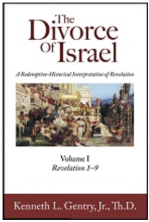
This long-awaited commentary is now at the printer and should be available for the public in late April, 2024. It is an 1800 page, two-volume deeply exegetical, academic commentary on the Bible’s most mysterious book.
Go here: https://www.kennethgentry.com/the-divorce-of-israel-2-vols-by-gentry-pre-publication-offer/
See more study materials at: www.KennethGentry.com
April 26, 2024
GENESIS PROVES POSTMILLENNIALISM
 PMW 2024-032 by Kendall Lankford
PMW 2024-032 by Kendall Lankford
[Gentry note:
This nicely presented, insightful article appears on The Shepherd’s Church website (The Shepherd’s Church is located at: 10 Jean Ave. Suite 12, Chelmsford, Mass.).]
INTRODUCTION
If you have been with us over the last 8 weeks, we have been attempting to summarize what a failed eschatology looks like. From the hyper-defeatism of dispensationalism and premillennialism to the subtle apathy for cultural engagement that seeps in through amillennialism and the Radical Two Kingdoms, we have been attempting to show that a wrong view of eschatology will have an impact on how you live in the world. Because let’s face it, if you believe that we lose down here (As John MacArthur famously said), we will not work down here. If we believe the rapture is always moments away, then why waste your time doing the long work of making disciples and transforming culture? If we believe that all of our energy and effort should go into spiritual activities (the Kingdom of God) and that this work does not overlap with the physical world (The Kingdom of Man), then why engage at all? Why obey Jesus’ command to be salt and light in the world if the only aspect we will ever see redeemed is spiritual? Better to spend your time converting souls for a Gnostic utopia than Biblically discipling nations to live with Jesus in the New Heavens and New Earth.
While each of the views we have covered so far has minimal overlap, two things they do have in common are that they are entirely wrong about eschatology and that they have throttled down the church so that she has become a passive-sickly agent in this world. In this series, we have been looking to change that.
And that brings us to our topic for today. How is Postmillennialism the correct view of eschatology? What does it mean? What implications will it have on my life? Can it be demonstrated convincingly from the Scripture?
To that end, let us begin by defining Postmillennialism, and then we will spend the majority of our time today showcasing this view in the pages of Genesis.

As It Is Written: The Genesis Account Literal or Literary?
Book by Ken Gentry
Presents the exegetical evidence for Six-day Creation and against the Framework Hypothesis. Strong presentation and rebuttal to the Framework Hypothesis, while demonstrating and defending the Six-day Creation interpretation.
See more study materials at: www.KennethGentry.com
WHAT IS POSTMILLENNIALISM?
Unlike the smorgasbord of major depressive eschatologies, Postmillennialism uniquely grapples with the unstoppable power of God, the awesome glory of Jesus’ Gospel, and how the earth will come under the Lordship of Christ the King before this rodeo is over. Instead of presenting Jesus’ great commission as an absolute failure, Postmillennialism takes seriously how the Gospel will change hearts, the church will disciple societies and nations (Matthew 28:19), and because Satan is bound (Matthew 12:29; Revelation 20:2), and the principalities and powers have been disarmed (Colossians 2:15), Jesus will win back the world and will bring it under His Father’s rule (1 Corinthians 15:24-28).
Central to this perspective is the understanding of what eschatology is. Eschatology is not the poorly written conclusion or the explosive plane crash of an otherwise glorious trip. Eschatology is concerned with how everything that was lost in the first Adam will be restored under the Lordship of the second Adam, Jesus Christ. Eschatology is not the final chapter where everything falls apart; it is the story of how everything comes back together in Jesus. This distinction is crucial.
With that in mind, Postmillennialism acknowledges that everything that fell in the first creation will be healed and restored by Jesus in His new creation, the Kingdom. To clarify, we are saying that this New Creation kingdom began when He ascended into heaven and will not be finished until everything is restored when He makes “His blessings flow far as the curse is found” (Joy to the World; Isaac Watts, 1719).
The postmillennial conviction is that God will do this by filling the world with worshipers who will worship Him in Spirit and Truth (John 4:23-24). Why? Because that is the end for which God designed the world (Genesis 1:28). At the heart of postmillennial thinking is the idea that God is going to redeem all that was lost in Adam, that He will fill the fallen world with worshippers in garden spaces, where He will bring the Kingdom of God across a globe that was under the tyranny of the devil. He will do that through the preaching of the Gospel, the making of disciples, and through the life-changing work of the Holy Spirit. As Christians, we know Christ never fails at anything He sets about to do. Thus, because Christ has endeavored to bring the world under His rule, He will not stop until He has been successful everywhere the curse is found.
According to the postmillennialist, this process of worldwide Kingdom expansion began when Jesus ascended into heaven and sat on His throne to rule, inaugurating a period known as the “Millennium” (Revelation 20), which is not a chronological term but symbolic of this growing epoch when righteousness, peace, and the acknowledgment of God’s sovereignty become pervasive realities. This era will be marked by an unprecedented increase in the number of worshipers who live out and celebrate the truth of God’s Word, culminating in a world saturated with adorations and praise for Yahweh, our King.
Thine Is the Kingdom
(ed. by Ken Gentry)
Contributors lay the scriptural foundation for a biblically-based, hope-filled postmillennial eschatology, while showing what it means to be postmillennial in the real world.
See more study materials at: www.KennethGentry.com
Unlike escapist or pessimistic eschatologies, Postmillennialism sees the future as a canvas for God’s redemptive work, transforming not just individuals but whole families, cultures, and nations. This view does not naively ignore the presence of sin and misery in the world but instead acknowledges a substantial decrease in its power and influence by the Risen Lord Jesus. Through this global transformation, which will happen slowly over many generations, the world will experience a foretaste of heaven as more and more people come to know God, are filled with His Spirit, and begin living out Christ-like behaviors and attitudes on earth.
Knowing this, the postmillennial vision compels Christians to engage actively in the world, driven by the certainty that their labor in the Lord is not in vain. Believers are called to spread the aroma of Christ in every sphere of life, laboring in hamlets, highways, high rises, downtowns, white houses, and empires that must be transformed into communities of worshipers before the Lord returns. This eschatological outlook infuses our daily living with purpose and direction, motivating us to partake in the divine mission of filling the earth with the knowledge of God as the waters cover the sea (Habakkuk 2:14).
In sum, Postmillennialism is God’s plan, in Christ, by the power of the Spirit, to fill the world with faithful worshippers. It is not just an eschatological viewpoint but a Biblical vision of the hope and redemption God promised to bring back into this fallen world. It is the only view that shows how everything lost in Adam will be found in the second Adam, Jesus Christ. It opens our eyes to the incredible successes of Christ in church history. It frees us to view the future optimistically even as we labor hard in the present. And in my opinion, it is the only view that accounts for what the Bible promises will happen in Jesus’ Kingdom.
So, with that, let us look at a positive and Biblical case for the doctrine of Postmillennialism from the book of Genesis.
A WORLD FILLED WITH WORSHIPERS BY DESIGN
God blessed them, and God said to them, “Be fruitful and multiply, and fill the earth, and subdue it; and rule over the fish of the sea and over the birds of the sky and over every living thing that moves on the earth.” – Genesis 1:28
To construct a Biblical eschatology, we must begin where the Bible begins. In the first chapter of Genesis, we see God’s plans and purposes for the world. A world made out of nothing. A world constructed without sin. A world in perfect conformity to the will of the Father, such that everything we behold in Genesis 1 pleases Him and is called very good by Him. If there was ever a way to discern the kind of world God would want, we must look no further than the one He made.
Why Not Full-Preterism? by Steve Gregg
This work exposes some of the key flaws in Hyperpreterism by someone who has formally debated them. Much insightful material for those who might be tempted to forsake historic Christian orthodoxy.
For more Christian educational materials: www.KennethGentry.com
In Genesis 1, after constructing heavenly space and earthly space, God made man with a unique and glorious purpose. After filling the cosmos to the brim with lights to rule the day and night, and after filling the skies with all kinds of birds and winged creatures, and after filling the oceans with teeming fish and sea monsters, and after filling the earth with every kind of animal and creeping thing, God also proposed to fill every square inch of this earth with humans, who would worship Him, and would spread His dominion and would rule over His creation to the glory of God. But, instead of beginning, as He did with a fixed and completed assortment of stars or with a fully multiplied ocean overflowing with sea beasts, God decided to begin with just two human bodies, made in His image, made to worship Him, both male and female, with the commission of using those two bodies to fill the four corners of this earth with their offspring (Genesis 1:28). To say that a different way, God Himself multiplied the galaxies and stars, as well as the winged and scaly beasts, but invited humans (the only creature God did this with) to partner with Him in their multiplication. This means God made human beings to become a multiplied species that filled the earth, but He allowed us to participate in our multiplication through monogamous covenant marriage.
Thus, we see the kind of world God wanted to make was a world filled with human worshippers, and by God’s grace, God invited humans to partner with Him in accomplishing that vision. This tells us all we need to know about God’s intention for the world. He created two sexual creatures to be bound in heterosexual covenant monogamy, to propagate the knowledge of God across the face of the earth through child rearing and family worship. This worshiping, fruitful, and multiplying family is what God called very good in Genesis 1, and this is what was so very bad about the fall in Genesis 3.
When sin entered the world, things fell. And by “fell,” I do not mean like a vase falling off a shelf, although as a metaphor that is not far off. What I mean is that everything God designed became broken. It no longer functioned in the way it was intended. And by everything, I mean everything. The earth fell. The land fell. Masculinity, femininity, marriage, and sex all fell. Moral reasoning, spiritual discernment, worship, creativity, and the ability to comprehend the knowledge of God all resoundingly fell. But what did not fall and was not broken was God’s intention to fill the world with worshiping people. This is where Postmillennialism is unique among the eschatological systems.
Instead of believing that God would give up on His “very good” plan and never accomplish what He set out to do initially, Postmillennialism sees God continually and consistently engaging with His fallen creation to ensure His plan will be accomplished. Again, God originally designed this world to be filled with human worshippers who spread His dominion and glory over every square inch of the land. With this in mind, those who ascribe to Postmillennialism do not see God abandoning that vision but gloriously and joyfully fulfilling it throughout Biblical and redemptive history.
In the following, I will sketch out, as briefly as I can, how God intends to fulfill His Genesis 1 vision of filling the world full of vibrant, faithful worshippers throughout the book of Genesis. Along the way, we will stop at various points and places in the Old Testament to see how God engages with sinful man to accomplish this plan. As you will see, these are the hopeful little breadcrumbs littered liberally along our Old Testament path. By the end, if you have eyes that are open to the text, you will not only see that God is still interested in this “very good” vision but also that in Jesus Christ, He absolutely will accomplish it.
[image error]For more information and to order click here.
" data-image-caption="" data-medium-file="https://postmillennialismtoday.files...." data-large-file="https://postmillennialismtoday.files...." class="alignright size-full wp-image-495" src="https://postmillennialismtoday.files...." alt="" />God Gave Wine (by Ken Gentry)
A biblical defense of moderate alcohol consumption. Considers all key biblical passages and engages the leading objections.
See more study materials at: www.KennethGentry.com
A WORLD FILLED WITH WORSHIPERS THROUGH NOAH
When man fell, He chose to fill the world with sin and sinners instead of the worship of God by godly worshippers. This polluting of the earth’s canvas began when Adam was thrust out of the garden (Genesis 3:23-24), and His family began multiplying transgressions on the surface of the land. Remember, it was his son Cain who painted the ground with Abel’s blood (Genesis 4:8). It was Lamech (the fifth generation from Adam) who boasted in gratuitous sin (Genesis 4:23-24); it was the prediluvian race of man who multiplied sin and misery all across the face of the earth (Genesis 6:5); and it was that demonically driven generation who interbred with the fallen angels to produce the race of giants called the Nephilim (Genesis 6:1-4).
In obedience to the nature God gave them, human beings multiplied what they most loved. But, instead of multiplying affection for God and holiness that they were designed to love, they multiplied the sins and miseries they were created to hate. This led to a period of unspeakable horrors on earth, as the only inclination of man at all times was just sin (Genesis 6:5). These acts of global rebellion and the sorry state that the world had fallen into provoked the wrath of Almighty God to destroy the world in the torrent of His furious holiness (Genesis 6:6-7).
In His justice, God was not obligated to save anyone. All had sinned and fallen short of the glory of God (Romans 3:23). All deserved His wrath (Ephesians 2:3). And yet God, in an act of unimaginable mercy, spares a single family, sets them apart for salvation instead of judgment, and then reiterates His commitment to having a world filled with godly worshippers. Take a look at what God says. When the ark came to rest on Mt. Ararat, and when Noah and His family disembarked the titan vessel, God spoke the following to Noah:
And God blessed Noah and his sons and said to them, “Be fruitful and multiply, and fill the earth. – Genesis 9:1
Far from being finished with His plan, He reiterates it! Think about it: if there were ever a time for God to redefine the terms or scrap the old plan to institute a new one, this would have been the time. And yet God does not do that. Instead, He reinstituted the same old plan that He gave Adam, showcasing that He had not forgotten it, had not abandoned it, and fully intended to accomplish it. Before God is finished with this physical world and Jesus returns, He will fill it with worshippers. This is what He enumerated to Noah.
A WORLD FILLED WITH WORSHIPERS THROUGH BABEL
After Noah died, his offspring and ancestors rebelled against the Lord as their Father Adam and his progeny had before. Instead of multiplying righteous worshippers to the ends of the earth, they multiplied a little faction of rebel sinners who refused to leave the plains of Shinar (Genesis 11:1-2). Instead of spreading outward, they decided to build upward, to build a tower that touched the heavens instead of people who blanketed the earth. This blatant rebellion against the plans of God occasioned the Almighty to come down and throw them into a fit of chaos and confusion (Genesis 11:3-9), subdividing them into all of the various people groups, tribes, ethnicities, and linguistic groupings. From this, it is clear that even in His judgment on them, He was committed to scattering humans to the four corners of this earth and filling the world with their offspring. This brings us to the promises of Abraham.
A WORLD FILLED WITH WORSHIPERS THROUGH ABRAHAM
After God accomplished the first part of His Genesis 1 plan . . . .
To finish the full article, click HERE
The Divorce of Israel: A Redemptive-Historical Interpretation of Revelation
This long-awaited commentary is now at the printer and should be available for the public in late April, 2024. It is an 1800 page, two-volume deeply exegetical, academic commentary on the Bible’s most mysterious book.
Pre-order today for a special discount. Click: HERE
See more study materials at: www.KennethGentry.com
Kenneth L. Gentry Jr.'s Blog
- Kenneth L. Gentry Jr.'s profile
- 85 followers



